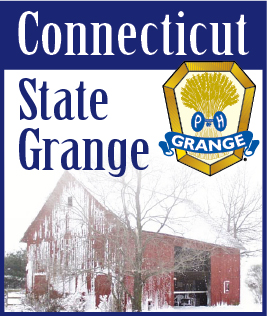| JANUARY 3, 2012 -- During the 2011 Grange State Session a resolution was introduced dealing with the fact that some operators of “big box” stores in Connecticut were selling plants which were on the “invasive plants” list, in violation of State Law. An invasive plant is a non-native species which aggressively moves into a native habitat and crowds out native plants. This changes the native habitat, especially by decreasing plant diversity and thus decreasing both the food that native animals depend on and also in some cases decreasing the available shelters for such animals. Invasive plants also cause problems for farmers and foresters, and aquatic invasive plants are a nuisance or even a threat both to commercial fisheries and to recreational boaters and anglers. Scientists have identified more than 400 invasive plants in Connecticut. Some of these pose much greater risks than others.
The resolution was re-written in committee, and the final resolution that was passed resolved that we urge the Connecticut General Assembly to increase funding to DEEP (the new Department of Energy and Environmental Protection) specifically earmarked for enforcement of laws banning sale of invasive plant species, and that we urge significant monetary fines or penalties to be imposed on any business which is found to have such plants for sale, and that all businesses selling plants receive and be required to acknowledge receipt of a list of invasive plant species along with a copy of the state law forbidding the sale of such plants.
In 2003 the General Assembly of the State of Connecticut created a 9-member Invasive Plants Council, which meets six to eight times a year in the Connecticut Department of Agriculture offices. The minutes of their meetings may be found on the web at: www.hort.uconn.edu/cipwg/IPC.
The duties of the Council are as follows:
(1) Develop and conduct a program to educate the general public and merchants and consumers of aquatic and land-based plants as to the problems associated with invasive plants; (2) make recommendations to control and abate the spread of invasive plants; (3) make available information regarding invasive plants available to any person or group who requests such information; (4) annually publish and periodically update a list of plants considered to be invasive or potentially invasive; and (5) support those state agencies charged with protecting the environment in conducting research into the control of invasive plants, including, but not limited to, the development of new varieties of plant species that do not harm the environment and methods of eradicating and managing existing species of invasive plants.
Invasive plants vary in their environmental and economic threat. One that has recently invaded Connecticut, the mile-a-minute vine (also called devil’s tearthumb), a member of the smartweed family, can grow up to a half-foot a day, and rapidly grows over other plants, killing or greatly weakening them by shading them out, stealing their nutrients, and choking them by tightly wrapping around their stems. The good news is that it is an annual, and is killed by the first good frost; the bad news is that it makes lots and lots of seeds, so that the next year there are hundreds of plants where there was only one the year before. Up-to-date information about this invader can be found at: http://www.hort.uconn.edu/mam/
Invasive Species List:
As provided by the Connecticut Invasive Plants Council. The following list only provides the common name. Scientific names and synonyms are also available on the website listed above. This list was last updated in October 2011.
American water lotus
Amur honeysuckle
Amur maple
Autumn olive
Belle honeysuckle
Bittersweet nightshade
Black locust
Black swallow-wort
Border privet
Brazilian water-weed
Bristled knotweed
Brittle water-nymph
California privet
Canada bluegrass
Canada thistle
Coltsfoot
Common barberry
Common buckthorn
Common kochia
Common reed
Common water-hyacinth
Crested late-summer mint
Crispy-leaved pondweed
Cup plant
Cypress spurge
Dame’s rocket
Drooping brome-grass
Dwarf honeysuckle
Eulalia
Eurasian watermilfoil
European privet
European waterclover
False indigo
Fanwort
Fig buttercup
Flowering rush
Forget-me-not
Garden heliotrope
Garden loosestrife
Garlic mustard
Giant hogweed
Giant knotweed
Giant salvinia
Glossy buckthorn
Goutweed
Ground ivy
Hairy jointgrass
Hydrilla
Japanese barberry
Japanese honeysuckle
Japanese hops
Japanese knotweed
Japanese sedge
Japanese stilt grass
Jimsonweed
Kudzu
Leafy spurge
Mile-a-minute vine
Moneywort
Morrow’s honeysuckle
Multiflora rose
Narrowleaf bittercress
Norway maple
Onerow yellowcress
Oriental bittersweet
Ornamental jewelweed
Pale swallow-wort
Parrotfeather
Perennial pepperweed
Pond water-starwort
Porcelainberry
Princess tree
Purple loosestrife
Ragged robin
Reed canary grass
Reed mannagrass
Rugosa rose
Russian olive
Scotch thistle
Sheep sorrel
Slender snake cotton
Spotted knapweed
Star-of-Bethlehem
Sycamore maple
Tansy ragwort
Tatarian honeysuckle
Tree of heaven
Variable-leaf watermilfoil
Water chestnut
Water lettuce
Watercress
White poplar
Wineberry
Winged euonymus
Yellow floating heart
Yellow iris
|
